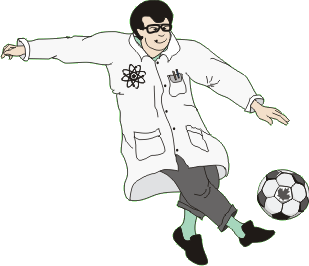|
Published in the June 2014
issue of the Canadian
Nuclear Society Bulletin, Vol.35, No.2.
Say Whaa...?
by Jeremy Whitlock
In the nuclear business one expects to be quizzed about blowing things up or glowing in the dark fairly frequently - these are the things that brand the technology in the public mind.
We need a new brand, a "wow" factor - the 30-second TED talk in the kitchen parties of the world that leaves listeners brimming with factoids they can't wait to share with an unsuspecting spouse or bowling buddy. The "Say Whaa..?" at the water cooler that leads to repetition and the spread of cool ideas!
Fortunately there is ample fodder for this exercise: as an industry we have never lacked in niftiness - only the gumption to tell anyone about it.
To wit, listed here are a few "did you knows?" that are bound to enthuse and bemuse (and hopefully not confuse):
- Atomic nuclei are wickedly small, but contain 99% of matter - meaning that we're really mostly empty space. It also means that everything we ever did as a species on this planet, until the middle of the last century, involved less than 1% of the energy around us. It took a global war to goad us into unlocking the remaining 99%, and even now we've only barely tapped that available potential.
- How small? Those nuclei are so small that if we expanded, say, a uranium nucleus to the size of a soccer ball (which is convenient for demos since each of the 238 protons and neutrons would be the size of a ping-pong ball), then the nearest-neighbour nucleus would be about 6 km away. Say whaa..? And now imagine a ping-pong neutron drifting around in that vast empty space, unattracted in any way to the soccer ball in the centre. It's a wonder reactors work at all...
- But man, do they work! So efficiently that a family's entire waste footprint, over everyone's entire lifetime, if all electrical needs were obtained from uranium alone, is the size of a fire log. And even then less than 1% of the potential energy of that "waste" has been utilized, making it more "slightly used fuel" than "waste".
- And the family's fire-log-sized footprint doesn't go anywhere: solid and small, it is readily stored - currently on-site at each of the reactor plants, but even if stacked like cordwood in one place, all the "slightly used fuel" generated since 1962 would still only fill a single soccer field to the height of a player. This is approximately half the volume of garbage generated by the city of Toronto each day. Say whaa..?
- What's more, dealing with the "slightly used fuel" in perpetuity (whether or not we as a species decide to extract the remaining 99% of energy from this material) is not the most complicated environmental stewardship humans will have to undertake. Nature herself is adept at isolating radioactive materials from the biosphere, which is the reason that concentrated uranium ore bodies still exist in the earth's crust in the first place, millions and often billions of years after they formed. And the most concentrated ore bodies in the world, in Saskatchewan's Athabascan Basin, are surrounded by enormous groundwater flow. We borrow the radioactive uranium from nature, use a fraction of its energy to make electricity and other products, then return it to nature in engineered repositories more robust than the environment in which it was found. That's the plan anyway; we're in no rush and have time to do it right.

- Other products? What other products? Well how about pharmaceuticals for treating and diagnosing disease. After World War II Canada found itself with the planet's second-largest nuclear infrastructure, and the world's most powerful research reactor - which we used to pioneer both nuclear medicine and cancer beam therapy. Canadian visionaries like Dr. Harold Johns and Dr. Sylvia Fedoruk carried the torch lit by Marie Curie, whose own driving passion (to her own detriment) was finding ways to use radiation to cure disease.
- In fact, nature has been using radiation to keep us alive since forever - not just at low environmental levels that stimulate our immune systems, but also distributed throughout the earth's interior, where the heat of uranium and thorium decay maintain the planet's magnetic field that makes all life on the surface possible.
- These wheels were put into motion by extraordinary Canadian leaders, during a time of massive upheaval, when the science of nuclear fission was still being figured out, with a simple "Okay, let's go" - the same resolve that carried Canadians onto Juno Beach a couple of years later. The leadership of the day sensed that this nucleus thing, small yet mighty, would unlock a new world and that Canada had a chance to hold one of the keys. Let's not lose the key.
Say whaa..?
|